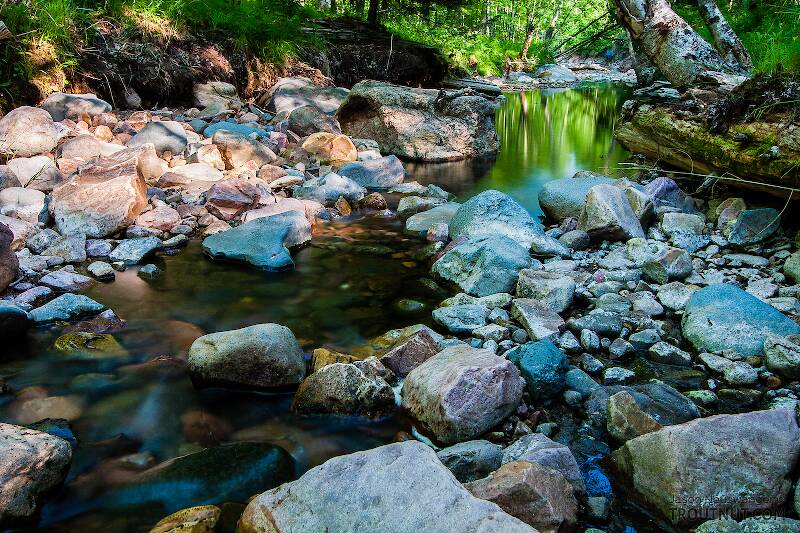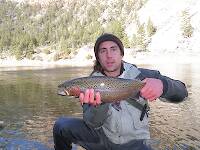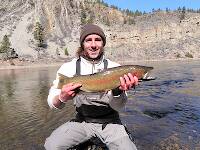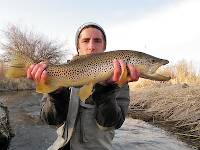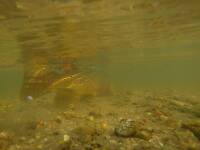
Hex Mayflies
Hexagenia limbata
The famous nocturnal Hex hatch of the Midwest (and a few other lucky locations) stirs to the surface mythically large brown trout that only touch streamers for the rest of the year.
Featured on the forum

I was not fishing, but happened to be at an unrelated social event on a hill above this tiny creek (which I never even saw) when this stonefly flew by me. I assume it came from there. Some key characteristics are tricky to follow, but process of elimination ultimately led me to Sweltsa borealis. It is reassuringly similar to this specimen posted by Bob Newell years ago. It is also so strikingly similar to this nymph from the same river system that I'm comfortable identifying that nymph from this adult. I was especially pleased with the closeup photo of four mites parasitizing this one.

Troutnut is a project started in 2003 by salmonid ecologist Jason "Troutnut" Neuswanger to help anglers and
fly tyers unabashedly embrace the entomological side of the sport. Learn more about Troutnut or
support the project for an enhanced experience here.
JAD on Jan 16, 2007January 16th, 2007, 4:16 am EST
Hi guys
This is quite a post, lots of history and very different styles of fishing. I think my own style of fishing is quite different, than most.
I'm older than you guys (The old bull) On a good day I might fish 100 yards of stream, when I'm done their is no stone unturned. I will work a strech and turn around and fish the same water again in a completely different style. When a fellow nymph fishes he or she has to have the ability to visualize where the fish will be holding in that time of day he will be fishing. That's where the weight management and presentation factor comes into the discussion.
Ryan -----(for the past 5 years. I know there are trout in the river but I haven't caught a fish there yet,)Ryan I think you need a coach that will show you the joys of hooking and landing fish. If you can't find any buddy to fish with see if you can rent some fishing DVd or tapes.
Regards.
JaD
This is quite a post, lots of history and very different styles of fishing. I think my own style of fishing is quite different, than most.
I'm older than you guys (The old bull) On a good day I might fish 100 yards of stream, when I'm done their is no stone unturned. I will work a strech and turn around and fish the same water again in a completely different style. When a fellow nymph fishes he or she has to have the ability to visualize where the fish will be holding in that time of day he will be fishing. That's where the weight management and presentation factor comes into the discussion.
Ryan -----(for the past 5 years. I know there are trout in the river but I haven't caught a fish there yet,)Ryan I think you need a coach that will show you the joys of hooking and landing fish. If you can't find any buddy to fish with see if you can rent some fishing DVd or tapes.
Regards.
JaD
They fasten red (crimson red) wool around a hook, and fix onto the wool two feathers which grow under a cock’s wattles, and which in colour are like wax.
Radcliffe's Fishing from the Earliest Times,
Shawnny3 on Jan 16, 2007January 16th, 2007, 5:04 am EST
Thanks for the history lesson, Gonzo.
Sorry about the name screw-up, Steve. I'd seen that before in your handle and didn't make the connection this time.
Good comments and critiques, all.
-Shawn
Sorry about the name screw-up, Steve. I'd seen that before in your handle and didn't make the connection this time.
Good comments and critiques, all.
-Shawn
Jewelry-Quality Artistic Salmon Flies, by Shawn Davis
www.davisflydesigns.com
www.davisflydesigns.com
Martinlf on Jan 16, 2007January 16th, 2007, 5:32 am EST
More Blake! Thanks JaD. Only on a Troutnut forum.
"He spread them a yard and a half. 'And every one that got away is this big.'"
--Fred Chappell
--Fred Chappell
Trowpa on Jan 16, 2007January 16th, 2007, 11:32 pm EST
Yes I have to say that I get perspective and depth of knowledge from this forum that I'd never get on any other site -
So a related question (i think it still belongs in this thread):
When passing through a pool (multiple times as JAD mentions) trying to find a fly and technique that will work I'm always changing flies, depth, technique, etc but I've never tried fishing two fly rigs - anyone do this much? I've read a bit about it, but never tried. Seems to me if the presentation can still be made well, you'd cut your experimentation time in half - presenting two different flies at the same time to see which will be taken, or perhaps the sum is greater than the parts: A big attractor nymph might draw attention to a smaller offering tied behind on a dropper.
What's the opinion here? Worth trying? or while learning to nymph should I stick to "one fly at a time" for a while?
Also - are there any regulation-related issues to having two flies on the line? (i.e. FFO / C&R regulations)
So a related question (i think it still belongs in this thread):
When passing through a pool (multiple times as JAD mentions) trying to find a fly and technique that will work I'm always changing flies, depth, technique, etc but I've never tried fishing two fly rigs - anyone do this much? I've read a bit about it, but never tried. Seems to me if the presentation can still be made well, you'd cut your experimentation time in half - presenting two different flies at the same time to see which will be taken, or perhaps the sum is greater than the parts: A big attractor nymph might draw attention to a smaller offering tied behind on a dropper.
What's the opinion here? Worth trying? or while learning to nymph should I stick to "one fly at a time" for a while?
Also - are there any regulation-related issues to having two flies on the line? (i.e. FFO / C&R regulations)
-Steve
Troutnut on Jan 17, 2007January 17th, 2007, 12:30 am EST
I've never tried fishing two fly rigs - anyone do this much? I've read a bit about it, but never tried. Seems to me if the presentation can still be made well, you'd cut your experimentation time in half
I do it a lot, and for exactly that reason. I prefer to fish one fly because of the easier casting and more natural drift, but I often fish two whenever I'm not sure which nymph to use. If one seems to be doing better I quickly remove the other. This works out pretty well for me.
Outside of nymphing I use two or more flies even more often. I very commonly use the dry + dropper, and when I'm swinging wet flies (my favorite way to cover a lot of water blind) I'll fish three of them where it's legal.
There are some regulations to worry about. Usually having more than one hook is forbidden on rivers with runs of lake fish because unsavory characters will abuse the priviledge to snag fish. Nobody was thinking "no two-fly rigs" when they made the law, but that technique is an unfortunate casualty of overly general lawmaking. In most places those kinds of regulations only apply to waters which get lake runs (even if you're not fishing for them), but it's a good idea to check your local rule book for other waters just in case.
Jason Neuswanger, Ph.D.
Troutnut and salmonid ecologist
Troutnut and salmonid ecologist
JAD on Jan 17, 2007January 17th, 2007, 4:33 am EST
Hi again ,it seams that this subject could be explored even deeper. Steve you hit one of the nails on the head--( A big attractor nymph might draw attention to a smaller offering tied behind on a dropper.)Their are many little tricks a man picks up over a life time of fishing for trout. --A little story-I fish western (Pa public water),The best and deepest hole is at the top of the run every buddy fishes it, the fish have seen every thing a man can buy and tie. In July in low clear water I knock those fish out using your statement I use a 18 Pheasant Tail with a 20 inch 8x dropper with a 26 PT and I raise the rig right in front of the fish ( like you said ) they spot the big nymph but they eat the small one. So Steve the answer is yes most definitely.
I often laugh to myself, in this sport their are Turtles and Hairs---- Country Boys and City Boys---- Talkers and Dewers--- takes all kinds, and I hope, room for everybody.
Well I rambled enought
Hope this helps-John
I often laugh to myself, in this sport their are Turtles and Hairs---- Country Boys and City Boys---- Talkers and Dewers--- takes all kinds, and I hope, room for everybody.
Well I rambled enought
Hope this helps-John
They fasten red (crimson red) wool around a hook, and fix onto the wool two feathers which grow under a cock’s wattles, and which in colour are like wax.
Radcliffe's Fishing from the Earliest Times,
Shawnny3 on Jan 18, 2007January 18th, 2007, 9:52 am EST
I agree with Jason and John that two-fly rigs can be very effective, and both describe excellent ways to use them. I use multiple flies almost exclusively.
I do have some problems fishing the common dry-with-dropper rig, though. For me, the nymph rolling over behind the dry often causes the dry to land sideways on the water if my cast is made at any angle other than completely vertical. Since I tend to cast at low arm angles a lot, I don't like to fish the dry-with-dropper much. But there are certain times and situations when I do it, though rarely at full casting distance, with excellent results. When I do this, I'm really using the dry to present the nymph in a particular way (this is not the same as using the dry as an indicator, although it may also serve that purpose). So I'm really nymphing.
Most of the time when I fish a two-fly rig it is when nymphing. I'm either trying to get more information faster or simply giving the fish some menu options, because rarely (if ever) will all the fish in the stream be focused on one particular fly. When I feel the need, as Jason said, or when I'm really desperate, I'll put on a third fly. I usually try to fish flies of different size, color, and pattern together, but I have been known to simultaneously throw multiple flies of the exact same pattern if the action is really specific.
Some rig considerations: Lately I've begun using rigs with the flies much closer together (as near as 8 inches apart), and with split-shot much closer to my flies (sometimes only a few inches away). Doing so gives me better line control, and thus allows me to get multiple entrees onto the dinner plate of a fish in a tight lie. If I fish the flies far apart, it is usually with a specific purpose: I'm either trying to fish them at different depths, in which case they are weighted accordingly, or I am fishing a wide, even run in which my flies will all drift at the same speed regardless of the distance separating them (though, in this second case, I still prefer my flies close together most of the time). Also, when using flies that lend themselves to it, I step down my tippet diameter between flies so that my smallest and last fly is on the lightest tippet, to both present the small fly as deceptively as possible and also to keep from losing my entire rig if I get the last fly hung up.
Just some thoughts.
-Shawn
I do have some problems fishing the common dry-with-dropper rig, though. For me, the nymph rolling over behind the dry often causes the dry to land sideways on the water if my cast is made at any angle other than completely vertical. Since I tend to cast at low arm angles a lot, I don't like to fish the dry-with-dropper much. But there are certain times and situations when I do it, though rarely at full casting distance, with excellent results. When I do this, I'm really using the dry to present the nymph in a particular way (this is not the same as using the dry as an indicator, although it may also serve that purpose). So I'm really nymphing.
Most of the time when I fish a two-fly rig it is when nymphing. I'm either trying to get more information faster or simply giving the fish some menu options, because rarely (if ever) will all the fish in the stream be focused on one particular fly. When I feel the need, as Jason said, or when I'm really desperate, I'll put on a third fly. I usually try to fish flies of different size, color, and pattern together, but I have been known to simultaneously throw multiple flies of the exact same pattern if the action is really specific.
Some rig considerations: Lately I've begun using rigs with the flies much closer together (as near as 8 inches apart), and with split-shot much closer to my flies (sometimes only a few inches away). Doing so gives me better line control, and thus allows me to get multiple entrees onto the dinner plate of a fish in a tight lie. If I fish the flies far apart, it is usually with a specific purpose: I'm either trying to fish them at different depths, in which case they are weighted accordingly, or I am fishing a wide, even run in which my flies will all drift at the same speed regardless of the distance separating them (though, in this second case, I still prefer my flies close together most of the time). Also, when using flies that lend themselves to it, I step down my tippet diameter between flies so that my smallest and last fly is on the lightest tippet, to both present the small fly as deceptively as possible and also to keep from losing my entire rig if I get the last fly hung up.
Just some thoughts.
-Shawn
Jewelry-Quality Artistic Salmon Flies, by Shawn Davis
www.davisflydesigns.com
www.davisflydesigns.com
Trowpa on Jan 18, 2007January 18th, 2007, 1:00 pm EST
Thanks - great ideas. Can't wait to try some out this weekend. My mind is already dizzy with the various combinations I might like to try. It will be a cold weekend here in PA...but I'll tough it out for a few hours just to try a few two-fly rigs out!
-Steve
Minnesota on Jan 18, 2007January 18th, 2007, 7:45 pm EST
When I am covering a stream and then coming back over it later on, I like to cast a larger fly first. Bigger fish will hit a big bait right away. Unless you don't care about fish size. I fish a big streamer; like a 4 inch leech or minnow pattern to bring out the big ones, or grasshoppers when in grasshopper season seem to catch fish. A few casts a hole, then moving. Either they will hit, or they won't. 4-5 inch is big enough here. I've found that smaller fish dont get spooked as much as biggies. Go for the biggies 1st!
Jason Moe
Minnesota on Jan 18, 2007January 18th, 2007, 7:52 pm EST
Sometimes I've found that adding more weight and letting things go slower helps alot. Fish it deep and slow. If all else fails, tie on your ugliest fly you have. It seems to work for me once in awhile.
Jason Moe
Trowpa on Jan 20, 2007January 20th, 2007, 3:19 am EST
Ha! I completely agree with the "ugliest fly" - my most prized fly is one I designed on my own and is the ugliest thing i've ever seen. There are flies that appeal to men and flies that appeal to fish.
-Steve
Martinlf on Jan 20, 2007January 20th, 2007, 4:59 am EST
Amen. Though there are some flies that appeal to both.
"He spread them a yard and a half. 'And every one that got away is this big.'"
--Fred Chappell
--Fred Chappell
Trowpa on Jan 21, 2007January 21st, 2007, 8:06 am EST
Ok - got a couple hours in the back yard stream to try a two fly rig out - result? I actually got a trout! - unfortunately he came off at my knees before i could tell which fly he took :(
I used a woolly bugger as the lead fly (attention getter) and a little nondescript "ugly and buggy" dark brown nymph of my own design for a more realistic offering in the trailing position.
I've gotten in the habit of turning over rocks when i first get to the stream and approximate what I see - but I'm still trying to identify what I see - this site is very helpful in that..but I've got a long long way to go. Today I got as far as "hey that looks familiar - I think i saw it on troutnut.com...."
I used a woolly bugger as the lead fly (attention getter) and a little nondescript "ugly and buggy" dark brown nymph of my own design for a more realistic offering in the trailing position.
I've gotten in the habit of turning over rocks when i first get to the stream and approximate what I see - but I'm still trying to identify what I see - this site is very helpful in that..but I've got a long long way to go. Today I got as far as "hey that looks familiar - I think i saw it on troutnut.com...."
-Steve
Troutnut on Jan 21, 2007January 21st, 2007, 9:57 am EST
I've gotten in the habit of turning over rocks when i first get to the stream and approximate what I see - but I'm still trying to identify what I see - this site is very helpful in that..but I've got a long long way to go. Today I got as far as "hey that looks familiar - I think i saw it on troutnut.com...."
Hey, that's a good start!
I would caution you against putting too much priority on the bugs you see under the rocks. Anything on the underside of a rock you pick up is probably pretty good at clinging to the underside of a rock... which means it's probably not all that likely to be in the drift.
Still, it can tell you sometimes if one species is really abundant in the stream, and then it might be worth imitating. Also, if there are no other signs of bug activity, it is as good a starting point as any...
Jason Neuswanger, Ph.D.
Troutnut and salmonid ecologist
Troutnut and salmonid ecologist
Trowpa on Jan 21, 2007January 21st, 2007, 1:56 pm EST
thanks Jason - I figured as much - that what's under the rocks doesn't necessarily mean what's flowing through the water, but I like you said - i wanted to at least get a feel for what's in the stream.
Most of what I fish in this stream in the spring and summer is a light cream tinted mayfly. Sulphur? pale evening dun? i don't know - but my light cahill pattern sure works like a charm on them :)
I've been searching through the site trying to find what the nymphs i saw were (based on memory) - There were predomidantly two types - one bigger an fat and one much more slender. The big fat one had almost the exact shape as the Ephemerella subvaria or invaria - but i couldn't tell any further than that, as I'm not sure what else to look for do distinguish. I also didn't notice any lighter bands of color that your pictures show, but they were covered with mud and silt pretty good. I suppose i should've cleaned one up a bit and looked more closely. Next time I will... I don't remember much about the slender ones.
I suppose I should I carry something like a little jar to snatch up a sample to take home? I suppose that would be the best way eh?
Most of what I fish in this stream in the spring and summer is a light cream tinted mayfly. Sulphur? pale evening dun? i don't know - but my light cahill pattern sure works like a charm on them :)
I've been searching through the site trying to find what the nymphs i saw were (based on memory) - There were predomidantly two types - one bigger an fat and one much more slender. The big fat one had almost the exact shape as the Ephemerella subvaria or invaria - but i couldn't tell any further than that, as I'm not sure what else to look for do distinguish. I also didn't notice any lighter bands of color that your pictures show, but they were covered with mud and silt pretty good. I suppose i should've cleaned one up a bit and looked more closely. Next time I will... I don't remember much about the slender ones.
I suppose I should I carry something like a little jar to snatch up a sample to take home? I suppose that would be the best way eh?
-Steve
Troutnut on Jan 21, 2007January 21st, 2007, 5:47 pm EST
I also didn't notice any lighter bands of color that your pictures show, but they were covered with mud and silt pretty good. I suppose i should've cleaned one up a bit and looked more closely. Next time I will... I don't remember much about the slender ones.
I suppose I should I carry something like a little jar to snatch up a sample to take home? I suppose that would be the best way eh?
Yeah, it's pretty common that the nymphs are too covered in camouflage debris to show their identifying marks. It can help a lot just to cup a little water in your hand and stick the nymph in there to see it in a natural underwater state (with all the gills sticking out in the right direction and everything) instead of the matted-down form you get looking at the rock. A nymph out of water looks like a cat after a bath.
It's fun to take them home, too. You might want to check your state's regulations about that, but I doubt it will be a problem.
Jason Neuswanger, Ph.D.
Troutnut and salmonid ecologist
Troutnut and salmonid ecologist
Taxon on Jan 21, 2007January 21st, 2007, 8:31 pm EST
A nymph out of water looks like a cat after a bath.
That's a great description, Jason, and oh so true.
Minnesota on Jan 21, 2007January 21st, 2007, 8:41 pm EST
Most of the streams that I have never fished before; if fish are not that active for an ovious reason; lack of hatch; I usually try an adams dry size 14, if its darker out or a long cast, i'll do a lt cahill 14, or smaller to an ant 16, or black deer hair cricket at 16. Just to get a fish to sample. If you catch a fish, you can pump the stomach, or if you want dinner, you can bring it home and check the trouts dinner out. A size 10,12 black wooley bugger with a bunch of 2 in ostrich herls in the tail makes a good leech imitation. Add some lead wire in it to get it down.
Jason Moe
Jlh42581 on Jan 22, 2007January 22nd, 2007, 4:23 am EST
On catch & release streams in pa you are technically not allowed to keep even one nymph from that stream. Just a heads up.
Jeremy
Quick Reply
Related Discussions
Topic
Replies
Last Reply
Re: Moser, Grant, and GEM Skues Nephew to accept Fly Fishing Hall of Fame Awards
In General Discussion by Flymom
In General Discussion by Flymom
1
Oct 3, 2009
by JAD
by JAD

